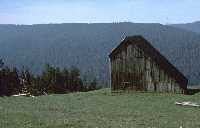At RNSP, visitors often come just to see the redwoods. They are the world's tallest trees, but they are also just one species in an incredibly varied ecosystem. From the wind-pruned, salt-tolerant Sitka spruce by the seaside, to the cool, moist redwood groves, and sunny, open grasslands of the prairies, visitors can find an interconnected community of greenery. In this narrow zone where land meets sea, salt-laden winds, cold fog-shrouded days, steep slopes, and sandy beaches conspire against plants.
Only the toughest survive. Their stunted size and wind-pruned shapes bear witness to an ongoing bout with the parks' harshest environment.
Dunes shift with the action of wind and water. Beach pea (Lathyrus littoralis), beach strawberry strawberry (Fragaria chiloensis), and sand verbena (Abronia spp.) adapt to this dynamic environment by anchoring themselves with long runners on or below the surface.
Hardy Sitka spruce (Picea sitchensis), able to withstand salt winds and harsh conditions better than other conifers, dominate the most exposed forest sites. Crescent Beach, Gold Bluffs Beach, Freshwater Lagoon Spit, and the Coastal Trail are great places to discover these tenacious maritime residents.
The coast redwood (Sequoia sempervirens) and Douglas-fir (Pseudotsuga menziesii) are the two dominant trees of the old-growth redwood forest. The species associated with redwood groves varies according to whether an area is upland, streamside (riparian), along a flood plain (alluvial), or close to the ocean.
Salt spray and salt-laden wind injure redwoods; the beach, dune, and scrub communities provide the coast redwood with a buffer from the harsh coastal climate.
The protected valleys and alluvial flats found along streams and creeks provide ideal growing conditions for the coast redwood, with many trees exceeding 300 feet (100 meters) in height. Other trees include hardwoods such as tanoak (Lithocarpus densiflorus), madrone (Arbutus menziesii), big-leaf maple (Acer macrophyllum), California bay or laurel (Umbellularia californica), and red alder (Alnus rubra). Sword fern (Polystichum munitum) and redwood sorrel (Oxalis oregana) are the most common members of redwoods' understory, and are accompanied by rhododendron (Rhododendron macrophyllum), huckleberry (Vaccinium spp.), salal (Gaultheria shallon), azalea (Rhododendron occidentale), and other shrubs.
On dry, windy slopes and ridges, redwood growth is limited by water stress. Here, trees may reach an average height of 200 feet (61 meters) or less.
At higher elevations, and further inland, redwood seedling establishment is limited by hotter, drier conditions, and the redwood forest gives way to a mixed evergreen forest. Dry forest species include Douglas-fir, tanoak, madrone, California bay, chinquapin (Chrysolepis chrysophylla), canyon live oak (Quercus chrysolepis), and Jeffrey pine (Pinus jeffreyi).






